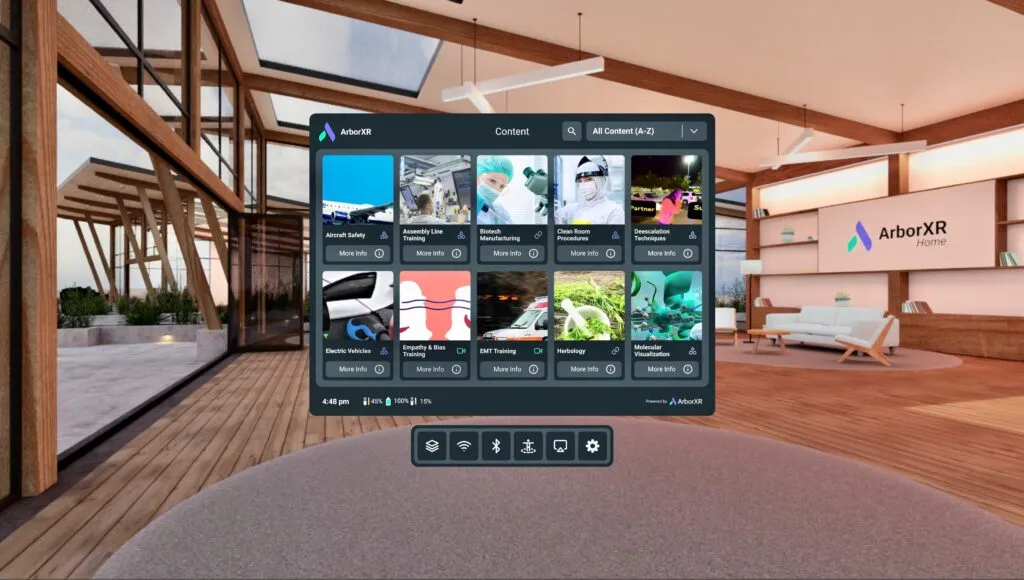Businesses everywhere are diving headfirst into XR. But with a new set of devices comes a new set of device management challenges.
Organizations adopting extended reality (XR) face a critical decision—choosing the right XR device management platform. Enterprises need an XR management platform that aligns with their goals to make the most of immersive technologies.
This guide compares two leading options:
- Workspace ONE XR Hub: An XR management module within Omnissa’s UEM platform.
- ArborXR: A dedicated XR device management platform built specifically for enterprises.
…to help you find the best fit for your organization.
Workspace ONE XR Hub: An Overview
VMWare Workspace ONE XR Hub (transitioning to Omnissa Workspace XR Hub) manages extended reality (XR) devices in enterprise environments. Built into the Workspace ONE unified endpoint management (UEM) platform, it extends device management capabilities to XR hardware alongside:

- Smartphones (Apple and Android)
- Tablets
- Desktops
- Laptops
- Servers
- IoT devices
The platform enables organizations to secure, customize, and control access to their XR devices through enterprise management tools.
Key Features of VMware (now Omnissa) Workspace ONE and Workspace ONE XR Hub
Device Management
Workspace ONE has basic AR and VR device management but many of the advanced features that admins have come to expect with laptops, phones and tablets aren’t available for XR devices.
XR Hub Application Environment
XR Hub's application launcher provides a customizable environment where users access their assigned VR applications.
Through its kiosk mode capabilities, supported devices can be configured to create locked-down, branded 3D environments tailored for VR customer experiences. These features work together to deliver a controlled user experience within XR.
SSO Integration
Built-in Workspace ONE Access enables secure Single Sign-On (SSO) for XR devices, balancing user convenience with security requirements.
Remote Rendering and Streaming
NVIDIA CloudXR integration supports complex XR applications through cloud-based graphics rendering, making high-end XR content accessible on less powerful devices.
Workspace ONE Pricing
Workspace ONE UEM, which includes XR Hub, offers four subscription tiers:
- Mobile Essentials: $3/device or $5.40/user monthly
- Desktop Essentials: $4/device or $7.20/user monthly
- UEM Essentials: $5.25/device or $9.45/user monthly
- Enterprise Edition: $10/device or $15/user monthly
All devices are treated equally under this pricing model—whether it’s a VR headset or a laptop.It’s also worth noting that this pricing model can be unfavorable for smaller organizations—especially when using Meta Quest devices (which will require both a Workspace ONE and a Quest for Business license).

Strengths of Workspace ONE (and XR Hub)
Strong Security Features (SSO Integration)
Workspace ONE is solid on security essentials. Its Single Sign-On (SSO) integration through Workspace ONE Access keeps devices secure.
Comprehensive Device Compatibility
Want to run Meta Quest 2 alongside devices from other OEMs? The platform handles various XR headsets as well as other devices through one system, making diverse fleet management possible.
Enterprise IT Integration
Many IT departments in large companies already use VMware products. Adding Workspace ONE XR Hub builds on existing systems and knowledge, making it easier to adopt and deploy.
Limitations of Workspace ONE for XR
Complex Setup Process
Setting up XR devices with VMware Workspace ONE XR Hub can be challenging. The process often requires creating XML files and using ADB commands. These requirements can be time-consuming and may require specialized technical skills.
XR-Specific Feature Gaps
While the platform supports XR devices, some XR-specific features are unavailable or still in development, such as:
- Workspace ONE doesn’t offer Remove View to see what users see in headset
- Lack of app version management and release channels
- Many admin features that work for phones/laptops don’t work for XR devices and admins may have to look through documentation to figure out what features are available.
These limitations make XR deployment and support less efficient than other XR-focused management platforms like ArborXR.
Other challenges admins and users face using Omnissa’s MDM solution:
Manual App Management
Application management is manual, meaning IT admins need to upload APKs and track app versions using external cloud storage. This lack of automation can make app management time-consuming and version control harder.
IT-Centric Management
The complexity surrounding the Workspace ONE ecosystem means only IT professionals can manage it. Organizations will depend on their IT departments for changes or updates, which can lead to delays and slower iterations.
Kiosk Mode
Kiosk mode, which allows devices to run in a locked-down state, is still in tech preview for certain devices, including Meta Quest devices. This limitation can affect the full functionality and security of XR deployments, restricting the user experience in some situations.
The Need for a Better XR Management Platform Than Workspace ONE XR
While Workspace ONE handles basic XR device management, it misses the mark on key requirements for XR-focused teams. The platform's complexity, IT dependency, and limited XR features create unnecessary hurdles for organizations deploying immersive technology at scale.
ArborXR addresses these gaps with an XR-first approach, particularly for teams focused on training, education, and enterprise applications.
ArborXR: A Better Alternative for XR Management
ArborXR is a dedicated XR management platform built for enterprise, training, and educational environments. Unlike more general device management tools like VMWare Workspace ONE, our platform has been designed from the ground up to simplify the complexities of deploying and managing VR, AR, and MR devices.

It streamlines XR device enrollment and management, enabling organizations to seamlessly integrate immersive technologies into their workflows without much IT intervention (if any).
Key Advantages of ArborXR over VMWare Workspace ONE + XR Hub
XR-Focused Management
ArborXR is purpose-built for XR device management, including VR, AR, and MR devices. It grants you full control to scale XR deployments and manage as many XR devices as you want. You also enjoy full support for Android-based AR/VR headsets, including popular brands like Meta, HTC VIVE, and PICO.
Easy App and Content Management
ArborXR provides a Content Library where you can upload all of your apps, videos, and webXR Links. This streamlined approach enables users to manage content effortlessly without relying on IT involvement, making it accessible to non-technical teams and ensuring smooth XR deployments.
Simplified Deployment
With ArborXR, app deployment is quick and straightforward. After uploading apps to your Content Library, you can manage versions through customizable release channels, and automate updates, ensuring all devices stay current and functional without any manual intervention or technical hassle.
Scalability
ArborXR can easily manage hundreds or thousands of XR devices, which is perfect for larger organizations looking to scale deployments while keeping the management process simple and centralized.
Remote View
A standout feature of ArborXR is its remote view. This allows administrators to see the user’s view in real-time, which is useful for providing remote support, guiding users, or troubleshooting problems directly.
Kiosk Mode
ArborXR's Kiosk Mode locks down devices to specific applications, providing a distraction-free environment for training, education, or dedicated enterprise use cases, ensuring controlled and streamlined experiences. Included with this customizing the home environment to meet your brand guidelines. From the background to the UI theme colors, create a fully branded and customized experience.
OS Updates
On certain devices like PICO and Magic Leap 2, ArborXR allows admins to remotely monitor and lock down devices to stable OS versions, manage testing devices, and roll out updates after verification. This reduces the risks associated with new or unstable operating systems.
Workspace ONE XR Hub vs. ArborXR: Head-to-Head Comparison
Device Management and User Experience
- Workspace ONE: Unifies XR and traditional device management but requires technical expertise and IT oversight.
- ArborXR: Focuses solely on XR, with an intuitive interface that empowers teams beyond IT. Walmart leveraged this simplicity to train over 1 million employees using VR, benefiting from the platform's open ecosystem and
App Management and Deployment
- Workspace ONE: Requires manual APK management and external cloud storage, creating a cumbersome workflow that depends on IT support.
- ArborXR: Features an integrated app library with automated version control and streamlined deployment. Delta Air Lines uses the remote deployment system to distribute VR training updates across sites instantly, eliminating manual updates.
Real Time Device Management
- Workspace ONE XR Hub: Does not support Remote View or Remote Launch of content
- ArborXR: Offers comprehensive control including Remote View and Remote Launch of content across all supported devices - Meta Quest, PICO, HTC VIVE, Lenovo, and DPVR. Bank of America achieved 97% employee confidence rates in their VR onboarding program using ArborXR with their deployment.

Kiosk Mode and Device Lockdown
- Workspace ONE XR Hub: Kiosk mode remains in tech preview for certain devices, limiting enterprise applications.
- ArborXR: Delivers full multi-app and single-app kiosk modes across all supported devices, with comprehensive home environment customization options including:
- Custom 360° backgrounds or 3D environments
- UI color theming to match brand guidelines
- Flexible navigation layouts
MyndVR uses this functionality to create simplified navigation for seniors and caregivers, focusing solely on VR experience selection.

App Version Control
- Workspace ONE: Manual version tracking creates administrative overhead and risks version inconsistencies.
- ArborXR: Automates updates through customizable release channels, maintaining version consistency across device fleets while enabling rapid content iteration.
Support and Ownership
- Workspace ONE: The platform is managed by IT teams, which can slow down XR deployments and limit control for other business units.
- ArborXR: Empowers business units and XR teams to manage content independently, enabling faster, more agile deployments. Your employees or users can now manage headsets on their own, thanks to ArborXR's ease of use and strong support system.
Final Verdict: ArborXR is a Better XR Management Platform for Enterprises
While versatile for managing various devices, Workspace ONE and XR Hub lacks the depth and XR-specific features that ArborXR offers and is more complex and IT-dependent.
ArborXR’s simplicity, ease of use, and XR-focused features make it ideal for immersive learning and training. If your focus is on XR for training, education, or enterprise, ArborXR provides a scalable and efficient solution.
Ready to simplify XR device management? Start your ArborXR free trial today.

